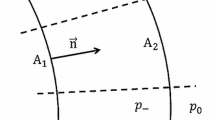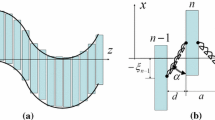Abstract
The herder’s scourge/whip motion dynamics is modeled and analyzed. Using generalized functions the potential and energy of the shock wave packet produced by the scourge motion are determined in terms of parameters of scourge and its initial velocity. The scourge is shown to be similar to a specific variable-mass rocket. This model is suggested as well for thundercracks. The reverse motion of scourge is applied to macroeconomics for modeling the growth of wealth characterized by the market index variation in time including bull, bear, and bull-bear markets.
Similar content being viewed by others
References
Cherepanov, G.P., Theory of Rolling. Solution of the Coulomb Problem, J. Appl. Mech. Tech. Phys., 2014, vol. 55, pp. 182–189.
Cherepanov, G.P., The Contact Problem of the Mathematical Theory of Elasticity Taking into Account Stick and Slip Zones. Theory of Rolling. Tribology, J. Appl. Math. Mech., 2015, vol. 78 (in press).
Author information
Authors and Affiliations
Corresponding author
Additional information
Original Text © G.P. Cherepanov, 2014, published in Fizicheskaya Mezomekhanika, 2014, Vol. 17, No. 6, pp. 99–103.
Rights and permissions
About this article
Cite this article
Cherepanov, G.P. Mechanics of scourge: Shock wave generation. An application to macroeconomics. Phys Mesomech 18, 174–178 (2015). https://doi.org/10.1134/S1029959915020101
Received:
Published:
Issue Date:
DOI: https://doi.org/10.1134/S1029959915020101




